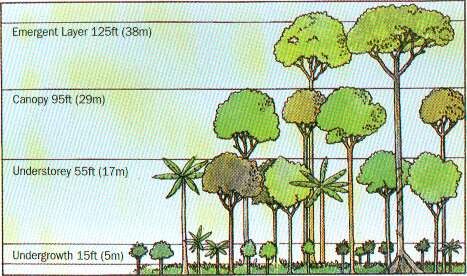Millions of distinctive ecosystems give rise to the
biome of tropical rainforest that can be both the terrifying Jungle of our
imagination or our myth’s Eden (Rainforest Alliance). Rainforests now only
cover less than 6% of the Earth’s land, yet it is estimated by scientists that more
than half of the world’s biodiversity resides there. It is astonishing that 40%
of the Earth’s oxygen is produced by the rainforests(Blue Planet).
The Earth’s most diverse ecosystem is located between
the tropics of Cancer and Capricorn at 3 main geographical sites. As the map of
Figure 1 shows, they are located in the Amazon basin in Central and South
America, in Africa at the Zaire basin and the eastern part of Madagascar and in
Southeast Asia from India’s west coast to Queensland, Australia.
Figure 1: Map of the Tropical Rainforest of the World-indicates by the bright yellow colour (NatGeo)
Their proximity to the equator is key to their
existence. Due to their location, rainforests have uniformly high temperatures
ranging from 20°C to 30°C and receive annually ≥2 m/yr of rainfall (WWF).
These factors in addition to the direct sunlight all year round contribute to
the high net primary productivity (Rainforest Conservation).
Plants
The
types of plants that exist in a rainforest are more than any other area on
Earth. It is astounding that as much as 70% of the flora or the rainforests are
trees. The rainforest generally consists of 4 distinct layers: forest floor,
understory, upper canopy and emergent. These characteristics allow them to have
close resemblance to on another. They
have straight smooth trunks up to the height of 100ft where there, they develop
branches creating the canopy layer. At that layer, it is where all the fun
happens. It is full of food and animals. Their trunks have a thin bark due to
their adaptation to the tropical climate where there is no need for protection
over water loss of freezing. Below that layer the understory layer there is not
much light penetration through and thus there only very few trees and shrubs
growing up to 60 ft. In addition to this the environment there is very humid as
there is little air movement. The lowest
level at the forest floor only a few herbs are grown there. The topsoil or
rainforests is very thin and poor in quality. It astonishes that Due to the
humidity and micro fauna litter is broken where a leaf in an ordinary climate
would decompose in 1 year, in the forest floor will only need 6 weeks. The top
layer is the emergent where trees are quite spaced and can reach up to 240ft
they are distinct since they grow above the canopy. Their trunks are very
smooth and to support their gigantic size they grow the famous buttress roots
for support over the thin topsoil (Blue Planet).
 |
| Figure 2: The Four Layers of the Rainforest (IHMC) |
Animals
The colour pallet and
patterns of all the types of animals living in rainforests is wonderful. Mammals
and birds dominate the canopy .In the rainforest it is never quiet. The
vocalizations of the animals are very distinct. Their diet is dependant heavily
on fruits. The largest group of animals in the rainforest are insects that have
developed various adaptations to camouflage from predation. These include
butterflies with bright colours and ant colonies. Rainforests have the highest
biodiversity of all biomes. It is estimated that in 1 hectare there could be
40-100 different species.
Even though they are
very similar, each on the main rainforest areas around the world are home for
different species of animals and trees. There are many species of monkeys that
are endemic only to that particular rainforest and thus do not exist in the
other 2 rainforests. There are also variations within a particular rainforest.
In the Amazon Brazil, there are species of trees that only grow in the
mountains and do not grow in the lowlands of the basin. This implies that the destruction
of even a small part of such a rich and diverse biome will have an irreversible
effect on biodiversity (Blue Planet).
The
difference in their location and the species of each particular rainforest
makes them special for our survival through the services that they provide to
human kind. On the following blogs, I will be discussing the ecosystem services
that the rainforest provide and you will be surprised on the amount as well as
types of services provided.

Hi Nikol,
ReplyDeleteThanks for the interesting overview on rainforests. I really enjoyed the picture you painted of the types of organisms that dwell in these rare and precious ecosystems. I'm looking forward to learning about ecosystems services provided by rainforests in your next post!
Katherine
Hi Nikol,
ReplyDeleteI agree with Katherine, this is a very interesting post! You describe the top layer of the soil as very thin and poor quality, so I would be very interested to learn how plants gain enough nutrients to survive in the rainforest if there is lots of competition with other plants and trees? There may be many answers to this, so even if you could just provide me with a few links to read more that would be great!
Thanks
Elena
Hello Elena,
DeleteThank you for your comment.
Rainforest trees have developed special roots for the uptake of nutrients called buttress roots. They are shallow root system that allows to reach nutrients where they are available the most which is the soil surface due to the very high decomposition rate. In addition to this, buttresses are very efficient in nutrient uptake from waterlogged soils such as the ones found in the tropics. These types of roots also help trees for competition for light. Since there is little sunlight penetrating through the canopy, trees grow into height >60ft. Buttress roots provide support and anchor themselves to the ground.
Hope this answers your question.
Take a look at these links which I found useful:
http://rainforest-australia.com/buttress.htm
http://www.blueplanetbiomes.org/rainforest.htm
http://www.srl.caltech.edu/personnel/krubal/rainforest/Edit560s6/www/plants/buttress.html
Nikol